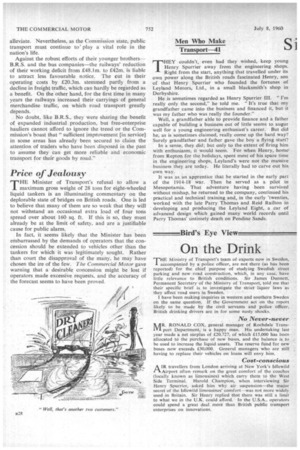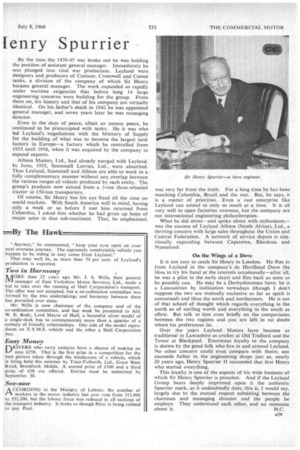Si fenry Spurrier
Page 32

Page 33

If you've noticed an error in this article please click here to report it so we can fix it.
HEY couldn't, even had they wished, keep young Henry Spurrier away from the engineering shops. Right from the start, anything that travelled under its own power along the British roads fascinated Henry, son of that Henry Spurrier who founded the fortunes of Leyland Motors, Ltd., in a small blacksmith's shop in Derbyshire.
He is sometimes regarded as Henry Spurrier III. "I'm really only, the second," he told me. "It's true that my grandfather came into the business and financed it, but it was my father who was really the founder."
Well, a grandfather able to provide finance and a father capable of building a business out of little seems to augur well for a young engineering enthusiast's career. But did he, as is sometimes claimed, really come up the hard way? Surely grandfather and father gave the boy a flying start'?
In a sense, they did; but only to the extent of firing him with enthusiasm, it would Seem. For when Henry, home from Renton for the holidays, spent most of his spare time in the engineering shops, Leyland's were not the massive -business they are today. He literally had to carve out his own way.
It was as. an apprentice that he .started in the early part of the 1914-18 war. Then he served as a pilot in Mesopotamia. That adventure having been survived without mishap, he returned to the company, continued his practical and technical training and, in the early 'twenties, worked with the late Parry Thomas and Reid Railion in developing and producing the Leyland Eight, a car of advanced design. which gained many world records until Parry Thomas' untimely death on Pendine Sands.
By the time the 1939-45 war broke out he was holding the position of assistant general manager. Immediately he was plunged into vital war production. Leyland were designers and producers of Centaur, Cromwell and Comet tanks, a division of the company of which Sir Henry became general manager. The work expanded so rapidly under wartime exigencies that before long 14 large engineering concerns were building for the group. From there on, his history and that of his company are virtually identical. On his father's death in 1942 he was appointed general manager, and seven years later he was managing director.
Even in the days of peace, albeit an uneasy peace, he continued to be preoccupied with tanks. He it was who led Leyland's negotiations with the Ministry of Supply for the building of what was to become the largest tank factory in Europe—a factory which he controlled from 1953 until 1956, when it was acquired by the company to expand exports.
Albion Motors, Ltd., had already merged with Leyland. In June, 1955, Scammell Lorries, Ltd., were absorbed. Thus Leyland, Scammell and Albion are able to work in a fully complementary manner without any overlap between the various ranges of vehicle produced by each entity. The group's products now extend from a 3-ton three-wheeled tractor to 150-ton transporters.
Of course, Sir Henry has his eye fixed all the time on world markets. With South America well in mind, having only a week or so before I met him returned from Colombia, I asked him whether he had given up hope of major sales in that sub-continent. That, he emphasized, was very far from the truth. For a long time he has been watching Colombia, Brazil and the rest. But, he says, it is a matter of priorities. Even a vast enterprise like Leyland can attend to only so much at a time. It is all very well to open factories overseas, but the company are not international engineering philanthropists.
What he did stress—and spoke about with enthusiasm— was the success of Leyland Albion (South Africa), Ltd., a thriving concern with large sales throughout the Union and Central Federation. A network of service depots is continually expanding between Capetown, Rhodesia and Nyasaland.
On the Wings of a Dove It is not easy to catch Sir Henry in London. He flies in from Leyland in the company's de Havilland Dove (he likes to try his hand at the controls occasionally—after all, he was a pilot in the early days) and flies back as soon as he possibly can. He may be a Derbyshireman born: he is a Lancastrian by inclination nowadays (though I don't suppose the two are mutually exclusive so far as spirit is concerned) and likes the north and northerners. He is not of that school of thought which regards everything in the north as of sterling worth and everything in the south as effete. But talk to him even briefly on the comparisons between the two regions and you are left in no doubt where his preferences lie.
Over the years Leyland Motors have become as traditional in Lancashire as cricket at Old Trafford and the Tower at Blackpool. Enormous loyalty to the company is shown by the good folk who live in and around Leyland. No other concern could even compare with theirs; son succeeds father in the engineering shops just as, nearly 20 years ago, Henry Spurrier II succeeded that first Henry who started everything.
This loyalty is one of the-aspects of his wide business of which Sir Henry Spurrier is proudest. And if the Leyland Group bears deeply imprinted upon it the authentic Spurrier mark, as it undoubtedly does, this is, I would say, largely due to the mutual respect subsisting between the chairman and managing director and the people he employs. They understand each other, and no nonsense
about it. H.C.








































































































